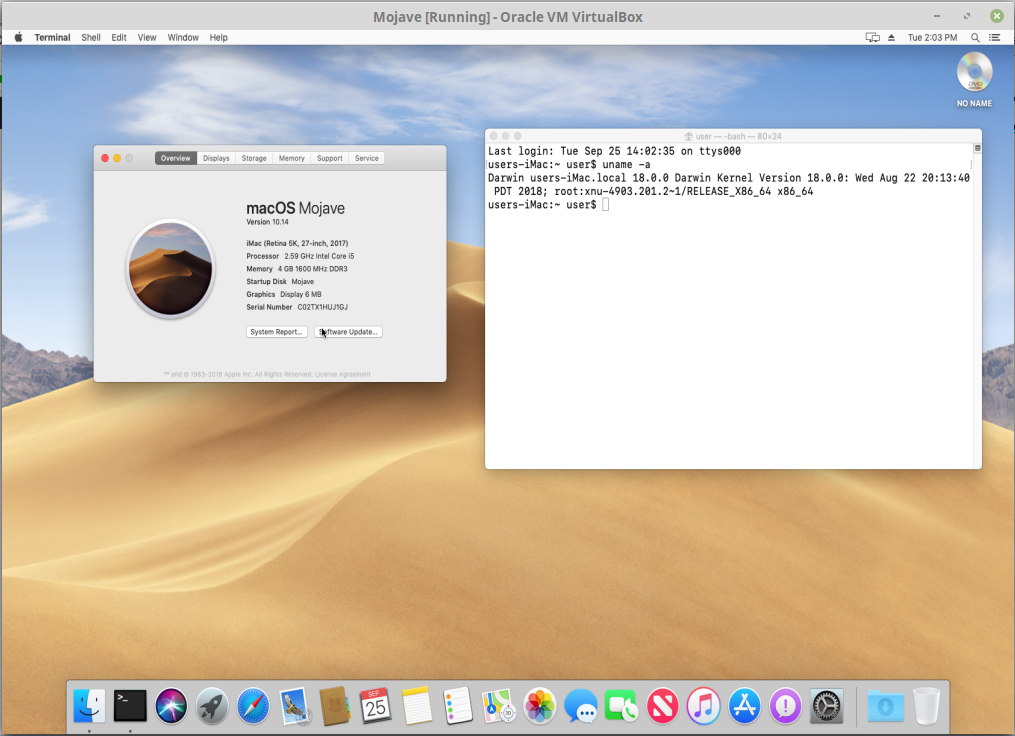

- #SET UP MAC OS MOJAVE VM INSTALL#
- #SET UP MAC OS MOJAVE VM DRIVER#
- #SET UP MAC OS MOJAVE VM SOFTWARE#
- #SET UP MAC OS MOJAVE VM CODE#
First, SSH into your Proxmox server so we can make some edits to the configuration files.Įdit /etc/pve/qemu-server/nf (with nano or vim). In the Hardware page for the VM, add a second DVD drive at IDE0, set it to use your Mojave-installer.iso.ĭon’t try to start the VM just yet. In the Options page for the VM, ensure that “use tablet for pointer” is set to “Yes”.
#SET UP MAC OS MOJAVE VM DRIVER#
Disable ballooning because there is no balloon driver available for macOS. Set the number of cores for the VM, I chose 4 (note that some core counts seem to be troublesome, try 4 first).Set the size of the hard disk (I chose 64GB).Set graphics to “VMWare Compatible”, set BIOS to OVMF (UEFI), set Machine to Q35, Tick Add EFI Disk, set SCSI to Default.Select the Clover ISO you uploaded and set OS type to “Other”.Make a note of it.Įvery Mac uses the same OSK, so don’t be surprised if it doesn’t look like a random string! Create the VMįrom the Proxmox web UI, create a new virtual machine as shown below.
#SET UP MAC OS MOJAVE VM CODE#
Run the first bit of C code from this page (you’ll need XCode installed) and it’ll print out the 64 character OSK for you. You can get around this by reading an authentication key out of your real Mac hardware (the OSK key).

MacOS checks that it is running on real Mac hardware, and refuses to boot on third-party hardware. iso file extension, this is actually a hard disk image. We’ll be using Clover as a bootloader for Mojave.ĭownload this Clover disk image (that I built using kholia’s build script from Clover r4920), unpack it, and upload it to Proxmox’s ISO store at /var/lib/vz/template/iso.
#SET UP MAC OS MOJAVE VM INSTALL#
In that case, you need to install the “dmg2img” package on your system, and replace the “hdiutil” command invocation with: dmg2img BaseSystem.dmg Mojave-installer.iso Prepare a Clover image It is possible to run this download script on Linux instead.

Upload the “ISO” to your Proxmox server’s ISO store (typically /var/lib/vz/template/iso). This is actually a raw disk image, not a true ISO, but Proxmox has better tools for picking and re-using ISO images than disk images. Convert that dmg into an “iso” like so: hdiutil convert BaseSystem.dmg -format UDRW -o Mojave-installer.iso This results in a ~460MB “BaseSystem.dmg” file in the current directory.
#SET UP MAC OS MOJAVE VM SOFTWARE#
On a Mac machine, download and run fetch-macOS-v2.py in a terminal to download the Mojave recovery image from the Apple software distribution server: Older CPUs will cause the finder to repeatedly crash after installation completes (with an Illegal Instruction exception in the graphics code).Īpparently modern AMD CPUs also support SSE 4.2 and can be used with this guide without any modification (maybe Bulldozer and certainly Ryzen), but I haven’t tested this myself. Your Proxmox host computer’s CPU must support SSE 4.2, so for Intel your CPU must be at least as new as Nehalem, which was the first CPU generation to bear the “Core” i5/i7 branding. You also need a real Mac available in order to fetch the OSK key. I’ll assume you already have Proxmox 5.4 installed. There is more documentation there which will help out with enabling extra features and diagnosing problems! Requirements This tutorial for installing macOS Mojave has been adapted for Proxmox 5.4 from Kholia’s GitHub project for installing into vanilla KVM. With the release of macOS Catalina 10.15, this tutorial is now obsolete! Please check out the new Catalina tutorial here.


 0 kommentar(er)
0 kommentar(er)
